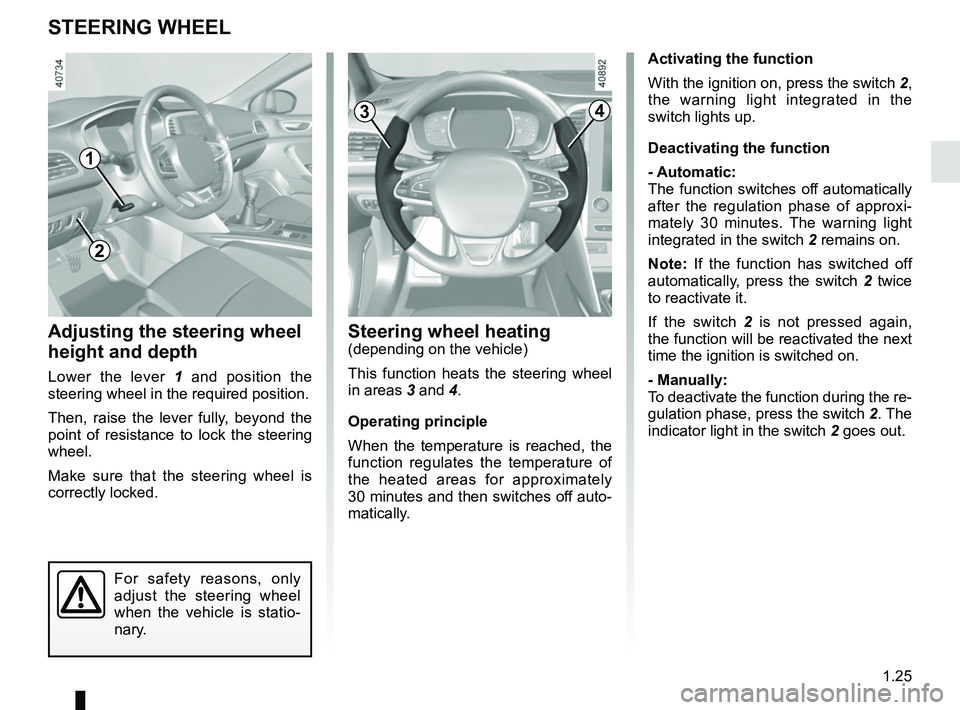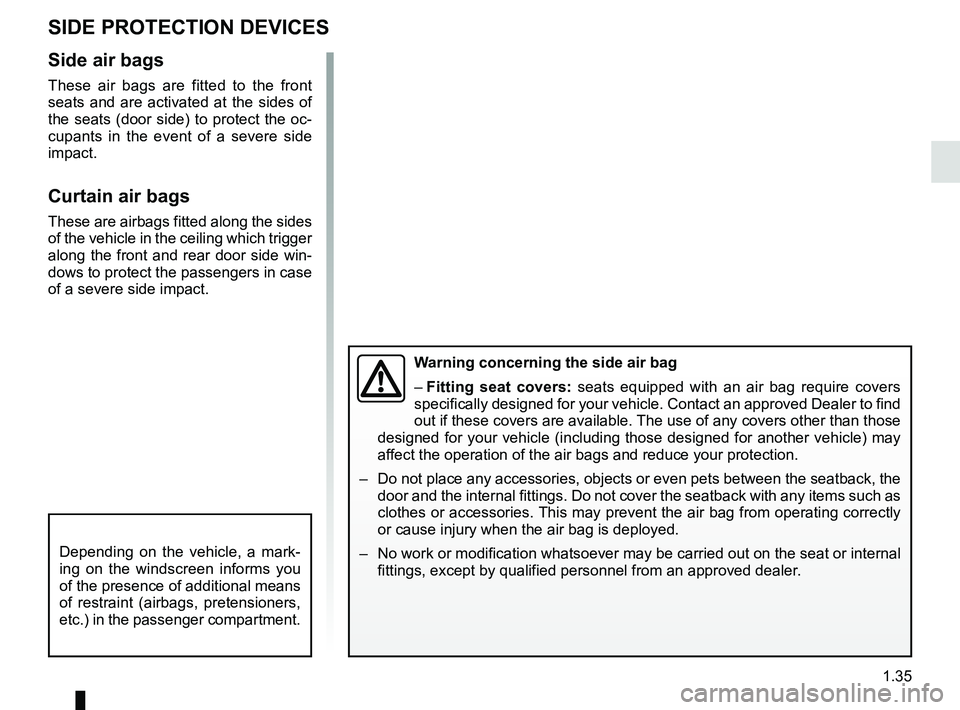Page 24 of 348
1.18
OPENING AND CLOSING THE DOORS (2/3)
4
Door/tailgate open buzzer
At a standstill, warning light 3 lights
up on the instrument panel alongside
warning light 4, indicating the opening
element(s) (door, boot) open or incor-
rectly closed. Once the vehicle reaches a speed of
approximately 12 mph (20 km/h), a
warning light indicates if the door(s) or
luggage compartment are open or im-
properly closed, along with the mes-
sage “Boot open” or “Door open” and a
beep will sound for around 40 seconds
or until the door/luggage compartment
is closed.
3
Page 30 of 348

1.24
Heated seats
With the ignition on:
– pressing the switch 8 on the required
seat for the first time activates the
heating system at maximum power.
Both integrated switch warning lights
come on;
– a second press decreases the heat- ing to minimum power. One inte-
grated warning light comes on;
– pressing for the third time turns the heating off.
FRONT SEATS (3/3)
7
MassageDriver
Massage
ON
Tonic Relaxing Lumbar
Intensity
Speed
– adjust the intensity (+ or -);
– adjust the speed (+ or -);
– reset the selected settings. Press 7
then “Reset”;
– activate/deactivate the massage seat (ON or OFF).
Note: the mode selected in the “Multi-
Sense" menu may affect the massage
configuration (please refer to the infor-
mation in "Multi-Sense" in Section 3).
Please refer to the multimedia equip-
ment instructions for further informa-
tion.
8
Functions
Massage
From the multimedia screen, you can
access the driver’s seat massage func-
tion. On equipped vehicles, the switch 6
provides direct access to the “Massage”
menu on the multimedia screen.
To activate the function:
– select the menu “Vehicle”, “Seats” then “Massage”;
– select the type of massage (“Tonic”, “Relaxing” or “Lumbar”);
6
Page 31 of 348

1.25
STEERING WHEEL
Steering wheel heating(depending on the vehicle)
This function heats the steering wheel
in areas 3 and 4.
Operating principle
When the temperature is reached, the
function regulates the temperature of
the heated areas for approximately
30 minutes and then switches off auto-
matically.Adjusting the steering wheel
height and depth
Lower the lever 1 and position the
steering wheel in the required position.
Then, raise the lever fully, beyond the
point of resistance to lock the steering
wheel.
Make sure that the steering wheel is
correctly locked.
For safety reasons, only
adjust the steering wheel
when the vehicle is statio-
nary.
1
Activating the function
With the ignition on, press the switch 2,
the warning light integrated in the
switch lights up.
Deactivating the function
- Automatic:
The function switches off automatically
after the regulation phase of approxi-
mately 30 minutes. The warning light
integrated in the switch 2 remains on.
Note: If the function has switched off
automatically, press the switch 2 twice
to reactivate it.
If the switch 2 is not pressed again,
the function will be reactivated the next
time the ignition is switched on.
- Manually:
To deactivate the function during the re-
gulation phase, press the switch 2. The
indicator light in the switch 2 goes out.
2
34
Page 33 of 348

1.27
SEAT BELTS (2/4)
Locking
Unwind the belt slowly and smoothly
and ensure that buckle 3 locks into
catch 5 (check that it is locked by pull- ing on buckle 3).
If the belt jams, allow it to return slightly
before attempting to unwind it again.
If your seat belt is completely jammed,
pull slowly, but firmly, so that just over
3 cm unwinds. Allow it to return slightly
before attempting to unwind it again.
If there is still a problem, contact an ap-
proved dealer.
1
5
3
4
5
ßDriver’s seat belt reminder
and, depending on the vehi-
cle, front passenger seat belt re-
minder
This lights up on the central display
when the engine is started. If the driv-
er’s or front passenger’s seat belt (if
this seat is occupied) is not fastened
and the vehicle has reached approxi-
mately 12.4 mph (20 km/h), it flashes
and a bleep sounds for around 120 sec-
onds.
Note: an object placed on the passen-
ger seat base may activate the warning
light in some cases.
Rear seat belt reminder
The warning light
ß lights up on
the central display accompanied, de-
pending on the vehicle, by a message
indicating the number of seat belts
buckled (for approximately 30 seconds)
or the graphic 6.
In all cases, these messages appear
with each:
– starting the vehicle;
– opening a door;
– fastening or unfastening of a rear seat belt (for this case, the informa-
tion is accompanied by a beep last-
ing approximately 30 seconds). Check that the rear passengers are
wearing seat belts and that the number
of seat belts shown as fastened cor-
responds to the number of rear seat
places occupied.
On the graphic 6:
– marker in green: seat belt fastened;
– marker in red: seat belt unfastened.
Unfastening
Press button 4 and the seat belt will be
rewound by the inertia reel. Guide the
belt.
6
6
Page 37 of 348

1.31
METHODS OF RESTRAINT IN ADDITION TO THE FRONT SEAT BELTS (2/4)
Load limiter
Above a certain severity of impact, this
mechanism is used to limit the force of
the belt against the body so that it is at
an acceptable level.
driver and passenger front
Airbags
Fitted to the driver and passenger
sides.
The presence of this equipment is indi-
cated by the word “airbag" on the steer-
ing wheel, dashboard (in the area of the
airbag A) and, depending on the vehi-
cle, a label on the lower section of the
windscreen.
Each airbag system consists of:
– an airbag and gas generator fitted on the steering wheel for the driver and
in the dashboard for the passenger;
– an electronic unit for system monitor- ing which controls the gas generator
electrical trigger system;
– remote sensors;
– a single warning light
å on the
instrument panel.
A
The airbag system uses py-
rotechnic principles. This
explains why, when the
airbag inflates, it will gener-
ate heat, produce smoke (this does
not mean that a fire is about to start)
and make a banging noise. In a situ-
ation where an airbag is required, it
will inflate immediately and this may
cause some minor, superficial graz-
ing to the skin or other problems.
Page 38 of 348
1.32
METHODS OF RESTRAINT IN ADDITION TO THE FRONT SEAT BELTS (3/4)
Operation
This system is only operational when
the ignition is switched on.
In a severe frontal impact, the airbags
inflate rapidly, cushioning the impact
of the driver's head and chest against
the steering wheel and of the front pas-
senger against the dashboard. The air
bags then deflate immediately so that
the passengers are not in any way hin-
dered from leaving the vehicle.
Operating faults
å This warning light comes on
when the engine is started and then
goes out after approximately three sec-
onds.
If it does not come on when the ignition
is switched on or if it stays on, there is a
fault in the system.
Contact your approved Dealer as soon
as possible.
Your protection will be reduced until this
fault is rectified.
Page 39 of 348

1.33
METHODS OF RESTRAINT IN ADDITION TO THE FRONT SEAT BELTS (4/4)
Warnings concerning the driver’s airbag
– Do not modify the steering wheel or the steering wheel boss.
– Do not cover the steering wheel boss under any circumstances.
– Do not attach any objects (badge, logo, clock, telephone holder, etc.) to the steering wheel boss.
– The steering wheel must not be removed (except by qualified personnel f\
rom our Network).
– Do not sit too close to the steering wheel when driving: Sit with your a\
rms slightly bent (see the information on “Adjusting your driving position” in Section 1). This will allow sufficient space for the air bag to deploy correctly and to be fully effe ctive.
Warnings concerning the passenger airbag
– Do not attach or glue any objects (badge, logo, clock, telephone holder\
, etc.) to the dashboard on or near the airbag.
– Do not place anything between the dashboard and the passenger (pet, umb\
rella, walking stick, parcels, etc.).
– The passenger must not put his or her feet on the dashboard or seat as t\
here is a risk that serious injuries may be sustained .
In general, parts of the body should be kept away from the dashboard (k\
nees, hands, head, etc.)
– The devices in addition to the front passenger seat belt should be react\
ivated as soon as a child seat is removed, to ensure the protection of the passenger in the event of an impact.
A REAR-FACING CHILD SEAT MUST NOT BE FITTED TO THE FRONT PASSENGER SEAT UNLESS THE ADDITIONAL RESTRAINT SYSTEMS, I.E. THE PASSENGER AIR BAG, ARE DEACTIVATED.
(refer to the information on “Child safety: deactivating/activating \
the front passenger airbag" in Section 1)
All of the warnings below are given so that the airbag is not obstructed in any way when it is inflated and also to prevent
the risk of serious injuries caused by items which may be dislodged when\
it inflates.
Page 41 of 348

1.35
SIDE PROTECTION DEVICES
Warning concerning the side air bag
– Fitting seat covers: seats equipped with an air bag require covers
specifically designed for your vehicle. Contact an approved Dealer to fi\
nd
out if these covers are available. The use of any covers other than those
designed for your vehicle (including those designed for another vehicle\
) may
affect the operation of the air bags and reduce your protection.
– Do not place any accessories, objects or even pets between the seatback,\
the door and the internal fittings. Do not cover the seatback with any items\
such as
clothes or accessories. This may prevent the air bag from operating correctly
or cause injury when the air bag is deployed.
– No work or modification whatsoever may be carried out on the seat or int\
ernal fittings, except by qualified personnel from an approved dealer.
Side air bags
These air bags are fitted to the front
seats and are activated at the sides of
the seats (door side) to protect the oc-
cupants in the event of a severe side
impact.
Curtain air bags
These are airbags fitted along the sides
of the vehicle in the ceiling which trigger
along the front and rear door side win-
dows to protect the passengers in case
of a severe side impact.
Depending on the vehicle, a mark-
ing on the windscreen informs you
of the presence of additional means
of restraint (airbags, pretensioners,
etc.) in the passenger compartment.